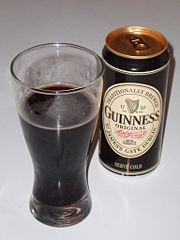|
|||
|
Philatelia.Net / Beer / Plots / The directory «Plots»GuinnessGuinness is a popular dry stout that originated in Arthur Guinness's St. James's Gate Brewery in Dublin, Ireland. The beer is based on the porter style that originated in London in the early 18th century. It is one of the most successful beer brands in the world, being exported worldwide. The distinctive feature in the flavour is the roasted barley which remains unfermented. For many years a portion of the beer was aged to give a sharp lactic flavour, but Guinness has refused to confirm if this still occurs. The thick creamy head is the result of the beer being mixed with nitrogen when being served. It is extremely popular with the Irish and is the best-selling alcoholic drink of all time in Ireland, where Guinness & Co. makes almost ˆ2 billion annually. Now available around the world, the brand is heavily associated with Ireland. The parent company has been headquartered in London since 1932 and was later merged with Grand Metropolitan plc and developed into a multi-national alcohol conglomerate named Diageo. Guinness stout is made from water, barley malt, barley, hops, and brewer's yeast. A portion of the barley is flaked (i.e. steamed and rolled) and roasted to give Guinness its dark colour and characteristic taste. It is pasteurised and filtered. Despite its reputation as a "meal in a glass", Guinness only contains 198 calories (838 kilojoules) per imperial pint (20 fl oz UK) (1460 kJ/l), fewer than an equal-sized serving of skimmed milk or orange juice and most other non-light beers. Draught Guinness and its canned counterpart contain nitrogen (N2) as well as carbon dioxide. Nitrogen is less soluble than carbon dioxide, which allows the beer to be put under high pressure without making it fizzy. The high pressure of dissolved gas is required to enable very small bubbles to be formed by forcing the draught beer through fine holes in a plate in the tap, which causes the characteristic "surge" (the widget in cans and bottles achieves the same effect). The perceived smoothness of draught Guinness is due to its low level of carbon dioxide and the creaminess of the head caused by the very fine bubbles that arise from the use of nitrogen and the dispensing method described above. "Original Extra Stout" contains only carbon dioxide, causing a more acidic taste. Contemporary Guinness Draught and Extra Stout are weaker than they were in the 19th century, when they had an original gravity of over 1.070. Foreign Extra Stout and Special Export Stout, with abv over 7%, are perhaps closest to the original in character. Although Guinness may appear to be black, it is officially a very dark shade of ruby. Arthur Guinness started brewing ales initially in Leixlip, then at the St. James's Gate Brewery, Dublin, Ireland from 1759. He signed a 9,000 year lease at £45 per annum for the unused brewery. Ten years later in 1769 Guinness exported their product for the first time, when six and a half barrels were shipped to England. Although sometimes believed to have originated the stout style of beer, the first use of the word stout in relation to beer was in a letter in the Egerton Manuscript dated 1677, almost 50 years before Arthur Guinness was born. The first Guinness beers to use the term were Single Stout and Double Stout in the 1840s. Guinness brewed their last porter in 1974. Guinness Stout is also brewed under licence internationally in several countries, including Nigeria and Indonesia. The unfermented but hopped Guinness wort extract (the essence) is shipped from Dublin and blended with beer brewed locally. The Guinness brewery in Park Royal, London closed in 2005. The production of allGuinness sold in the UK was switched to St. James's Gate Brewery Dublin. The breweries pioneered several quality control efforts. The brewery hired the statistician William Sealy Gosset in 1899, who achieved lasting fame under the pseudonym "Student" for techniques developed for Guinness, particularly Student's t-distribution and the even more commonly known Student's t-test. Guinness stout is available in a number of variants and strengths, which include:
A brewing byproduct of Guinness, Guinness Yeast Extract (GYE), was produced until the 1950s. Irland, 1959, Arthur Guinness Irland, 1959, Arthur Guinness Irland, 1992, Farm produce, bottle and glass of Guinness Irland, 2009, Arthur Guinness South Georgia And The South Sandwich Islands, 2002, South Atlantick Sea Mammals South Georgia And The South Sandwich Islands, 2002, Elephant seal Tristan da Cunha, 2003, World Geographical Records Tristan da Cunha, 2003, Edinburgh, Tristan da Cuhna Virgin Islands, 2002, Reptiles Virgin Islands, 2002, Spherodactylus pathenopian Irland, 2009.08.28, Advertising: |
|||
© 2003-2024 Dmitry Karasyuk. Idea, preparation, drawing up
|

